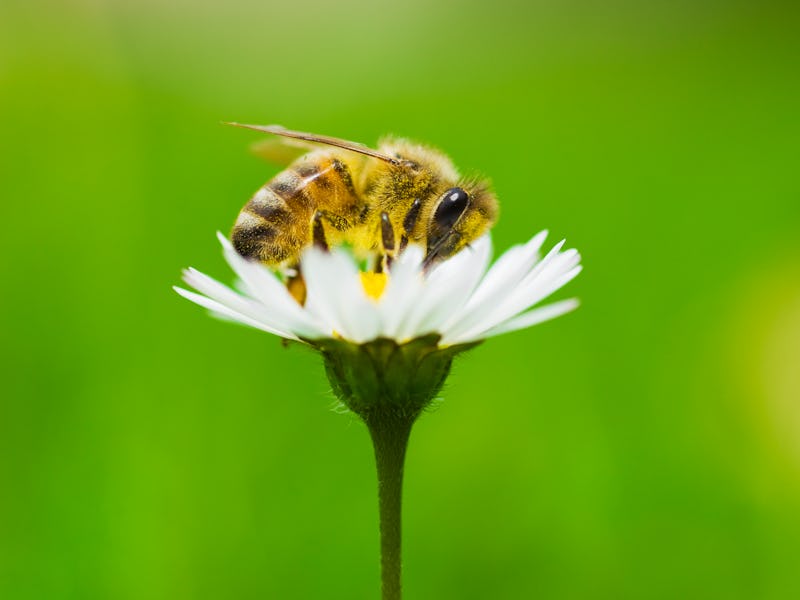Study: Bees might survive the climate crisis — but only some species
Bees are evolving in real-time due to warming temperatures.

Bees are perhaps Earth’s most essential pollinators. While hopping from flower to flower, these golden-hued insects don’t just suck sweet nectar but also transfer pollen among the plants — a crucial process that aids in plant reproduction. But as the climate crisis accelerates, insects like bees are in great peril as global warming threatens their habitats and food sources.
Yet, some bees’ are also adapting in new and perhaps unexpected ways to warmer climates, according to research published Wednesday in the journal Proceedings of the Royal Society B, potentially impacting these crucial pollination services.
What’s new — Scientists identified three key changes in bee traits — like diet and body size — as a result of warming temperatures and drier climates in mountainous climates.
First, researchers found that the relative abundance — which refers to the distribution of certain bees relative to the larger bee community — of larger bees declined, while the abundance of smaller bees increased.
Second, bees that tend to nest in holes or cavities — like the bumblebee — fared worse in warmer temperatures compared to bees that make their homes in the soil.
Finally, researchers learned climate change also affected diet in a surprising way: bees with a narrower, specialized diet seemed to benefit from less rainfall as their relative abundance increased. On the flipside, generalist bee species with a wider diet range did not benefit from the drier environment, and their relative abundance declined compared to the specialist bees.
On the whole, these findings suggest that global warming will alter important traits in bee communities, especially in mountainous climates.
“Our findings indicate that the bee community will likely shift towards smaller-bodied bees and solitary bees, bees that nest in the soil, and bees with narrower diet breadths,” Gabriella L. Pardee, lead author of the study and a postdoctoral researcher at the University of Texas at Austin, tells Inverse.
Bumblebees are important pollinators, but research suggests that smaller-bodied bees may fare better under warming conditions due to climate change.
Why it matters — Most bee studies focus on the well-known and highly social bumblebee, but few studies focus on the 20,000 other largely solitary bee species, limiting our understanding of the impacts of climate change on bees. The study calls this lack of data “concerning” given how the environment plays a “pivotal role” in bees’ flower pollination.
Since bees aid plant reproduction, humans need to understand the full impact of climate change across the 20,000 or so bee species, otherwise, our own future may be at stake. While previous research finds declining bumblebee populations and reduced habitats as a result of climate change, it’s possible other bees will be unaffected or could even benefit from climate change.
“Bees vary greatly in their foraging behavior and flower preferences across species, so by only focusing on bumblebees, we cannot fully understand how pollination services will become altered under climate change,” Pardee says.
Bumblebees are the primary pollinators in many ecosystems. It’s possible the increase in smaller bees — as seen in the study — could offset the declining pollination of bumblebees, but that kind of speculation is outside the scope of the research, according to Pardee.
How they made the discovery — To understand how a changing climate affects bees, the researchers headed to the Rocky Mountains. Mountainous systems are beneficial for studying climate change because their weather patterns change at a greater rate than in other ecosystems, according to the study
Over an eight-year period, the scientists collected bees every two weeks during the flowering season, using their collection to study the impact of climate change on important bee traits like body size, nesting habits, and diet. The researchers monitored the population of at least 154 bee species during this period.
“We found that bees exhibit differences in how well they will respond to climate change based on their life-history traits, which are physical traits or behaviors that affect growth, survivorship, and reproduction,” Pardee says.
What’s next — The researchers are hopeful their findings will serve as a wake-up call to protect bees. One of the best ways to do that: restore habitats for pollinators like bees.
“Planting a wide variety of native plants that are drought- or heat-tolerant would provide essential food and nesting resources for bees as temperatures continue to increase,” Pardee says.
Going one step further, Pardee suggests we need to ensure interconnected habitats so that bees can safely venture into “more suitable” environments as extreme weather events become more frequent.
“I hope that this study highlights the need for promoting bee diversity so we can maximize pollination services under a warming world,” Pardee says.
This article was originally published on